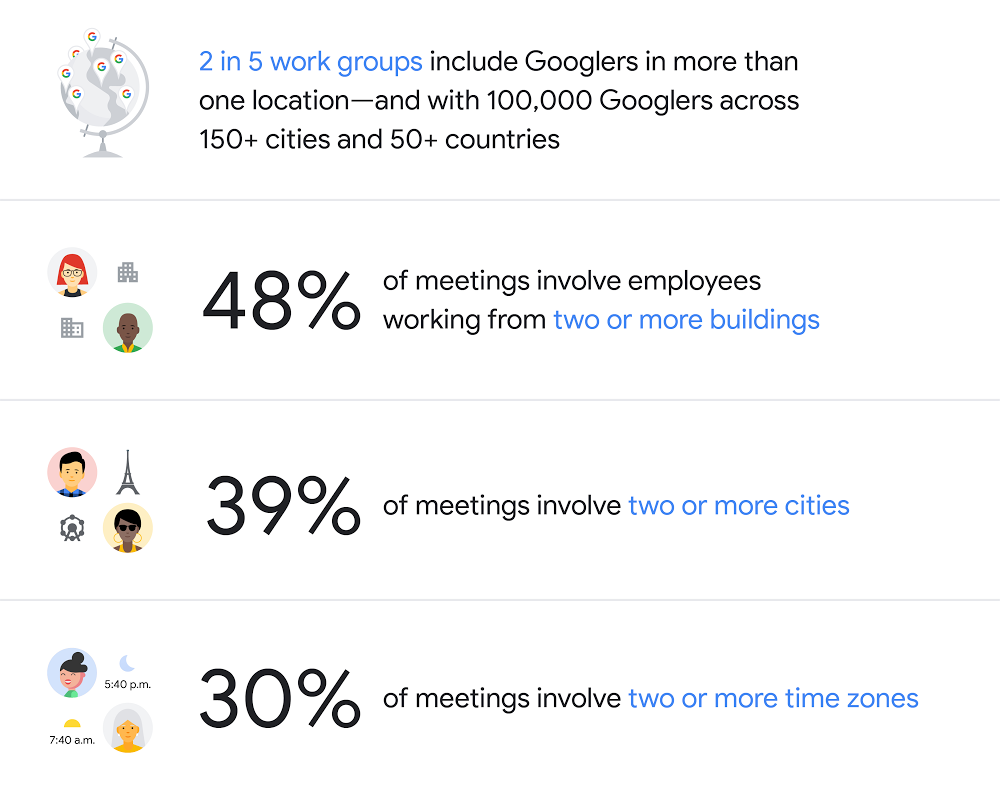As the manager of Google’s People Innovation Lab (PiLab) team, which researches making work better in and outside of Google, I regularly find myself performing what’s called “Distributed Work;” collaborating with teammates who aren’t based in San Francisco with me. It’s not unusual in a single day to be emailing with Googlers in Tokyo or Boulder for a quick chat or setting up weekly meetings via video chat with people in our New York offices. Coordinating these meetings can be difficult. Teammates in Asia often have to get up earlier than usual to join video chats and we try not to ask our East Coast colleagues to stay too far into their evening for meetings with the teams in Mountain View, California.
Outside of logistics, building relationships with teammates I don’t casually bump into in the hallway is a bit challenging. It feels natural to ask about after work plans or swap movie reviews when you’re meeting face to face, but it takes more effort to form that bond when you’re mostly seeing each other on a video screen.
With nearly 100,000 Googlers spread out over 150 cities in more than 50 countries, I suspected other teams face similar situations, and they are:

In order to better understand the impact of distributed work, my team sent out a survey to 5000+ Googlers and held focus groups with about a hundred employees across the globe. We measured well-being, performance, and connectedness (among other things) and came up with recommendations on how to ensure that those things remain consistent, even if your team is spread out across the world.
What we found
We were happy to find no difference in the effectiveness, performance ratings, or promotions for individuals and teams whose work requires collaboration with colleagues around the world versus Googlers who spend most of their day to day working with colleagues in the same office. Well-being standards were uniform across the board as well; Googlers or teams who work virtually find ways to prioritize a steady work-life balance by prioritizing important rituals like a healthy night’s sleep and exercise just as non-distributed team members do.At the same time, we did hear from Googlers that working with colleagues across the globe can make it more difficult to establish connections—in many senses of the word. Coordinating schedules across time zones and booking a conference room for a video chat takes more logistical brain power than dropping by a coworkers desk for a meeting over coffee. The technology itself can also be limiting— glitchy video or faulty sound makes impromptu conversations that help teammates get to know, and trust each other, seem like more trouble than they’re worth.
Making teams feel more connected
We consolidated our findings and best practices for distributed work in a set of playbooks to share with Googlers andother companies, too. Here are our top three tips for making distributed work feel more connected and enjoyable:- Get to know each other as people:Instead of jumping right into an agenda, allow some time at the top of the meeting for an open-ended question, like “what did you do this weekend?” It’s an easy way to build remote connections and establish a rapport. We found managers leading by example and making an extra effort to get to know distributed team members can be extra impactful.
- Set boundaries: Instead of making assumptions about preferred working hours, take the time to ask your co-workers when they like to take meetings; some may opt for a certain time of day if given a choice or like to disconnect completely from their computers at other times.
- Forge in-person and virtual connections: Sometimes it’s just easier to be face to face. Managers should provide clear guidelines and opportunities for team members to travel for in person meetings. On a video call, express reactions to coworkers ideas noticeably to indicate they’re being heard. When you do have the opportunity to meet for face to face interactions - take advantage in order to reinforce connections forged virtually.
As a manager of a distributed team, I’ve started to put these tips into action myself. I host virtual weekly lunches to create space for casual conversations between teammates and send weekly “Pi” (from PiLab) emails to share goals for the week, potential barriers to getting work done, wins or accomplishments, and an emoji to make it fun and personal. At Google, we're always looking to improve our practices to help Googlers do their best work, and hope this research will make it easier for teams to effectively and happily work together, no matter where they are based.